Report: Understanding and Leading Change in Tesco and Sainsbury
VerifiedAdded on 2023/01/13
|16
|5102
|57
Report
AI Summary
This report comprehensively examines leadership and change management within Tesco and Sainsbury, two major players in the UK retail sector. It begins by assessing various internal and external drivers of change, such as globalization, technological innovations, and institutional constraints, and analyzes how each organization has responded to these drivers. The report compares the approaches of Tesco and Sainsbury, highlighting similarities and differences in their strategies. It then evaluates the impact of these drivers on leadership, team, and individual behaviors, and explores measures taken to minimize the negative effects of change on organizational behavior. The report applies theories and models, including Lewin's Change Management Model, to critically evaluate organizational responses to change. Furthermore, it incorporates a force field analysis to identify driving and resisting forces, and analyzes the barriers to change, providing insights into how these forces influence leadership decision-making. Finally, it applies different leadership approaches and models to implement successful change within the organizational context, critically evaluating their effectiveness.
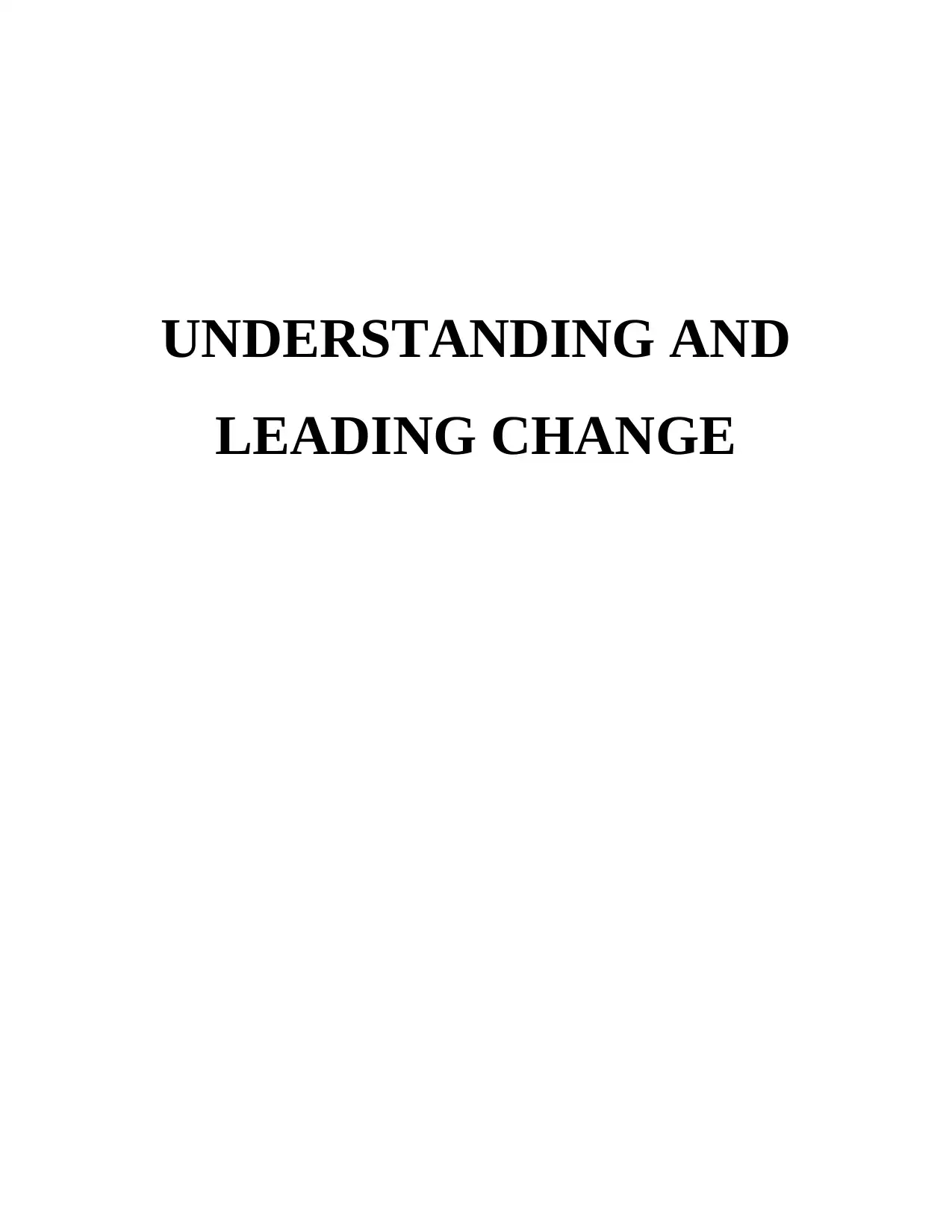
UNDERSTANDING AND
LEADING CHANGE
LEADING CHANGE
Paraphrase This Document
Need a fresh take? Get an instant paraphrase of this document with our AI Paraphraser
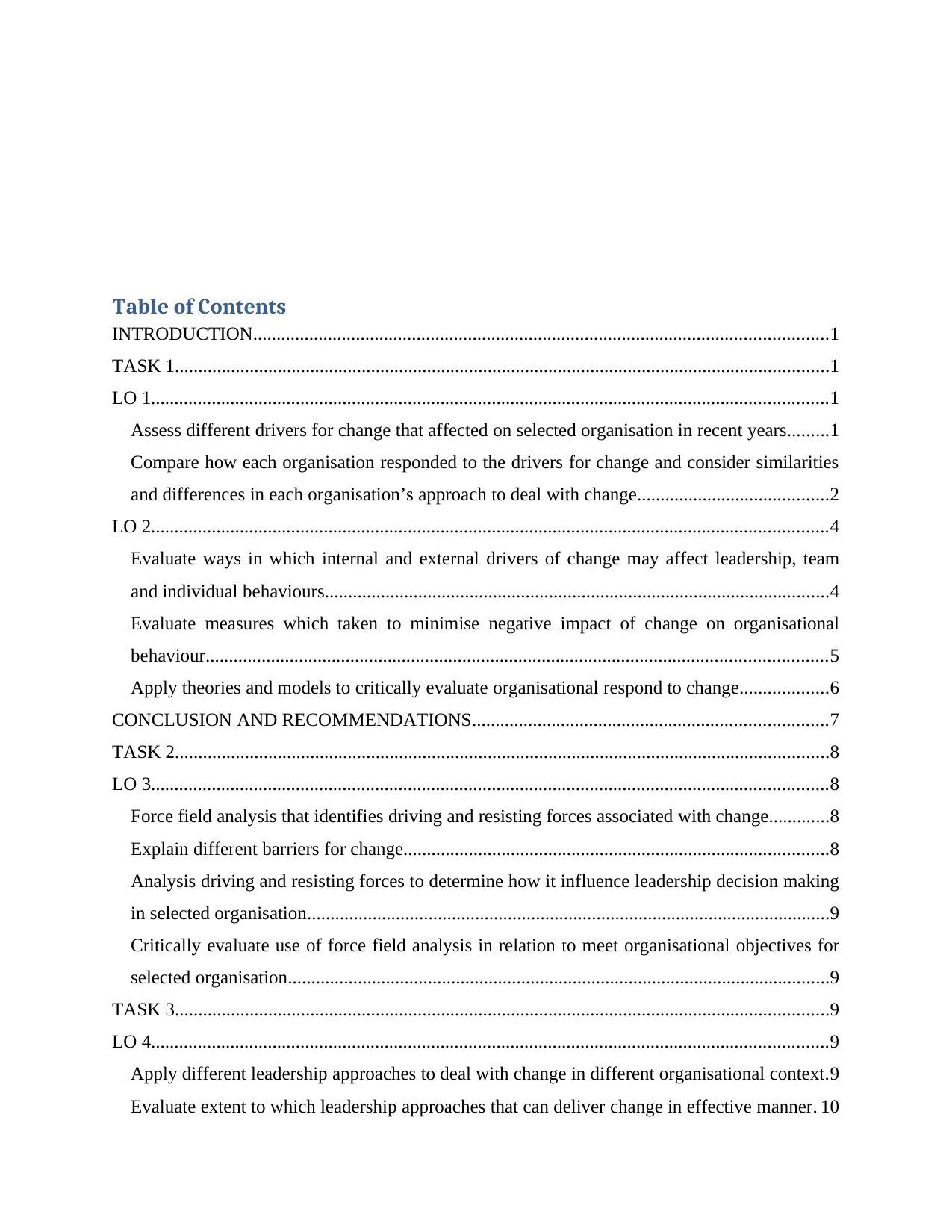
Table of Contents
INTRODUCTION...........................................................................................................................1
TASK 1............................................................................................................................................1
LO 1.................................................................................................................................................1
Assess different drivers for change that affected on selected organisation in recent years.........1
Compare how each organisation responded to the drivers for change and consider similarities
and differences in each organisation’s approach to deal with change.........................................2
LO 2.................................................................................................................................................4
Evaluate ways in which internal and external drivers of change may affect leadership, team
and individual behaviours............................................................................................................4
Evaluate measures which taken to minimise negative impact of change on organisational
behaviour.....................................................................................................................................5
Apply theories and models to critically evaluate organisational respond to change...................6
CONCLUSION AND RECOMMENDATIONS............................................................................7
TASK 2............................................................................................................................................8
LO 3.................................................................................................................................................8
Force field analysis that identifies driving and resisting forces associated with change.............8
Explain different barriers for change...........................................................................................8
Analysis driving and resisting forces to determine how it influence leadership decision making
in selected organisation................................................................................................................9
Critically evaluate use of force field analysis in relation to meet organisational objectives for
selected organisation....................................................................................................................9
TASK 3............................................................................................................................................9
LO 4.................................................................................................................................................9
Apply different leadership approaches to deal with change in different organisational context.9
Evaluate extent to which leadership approaches that can deliver change in effective manner. 10
INTRODUCTION...........................................................................................................................1
TASK 1............................................................................................................................................1
LO 1.................................................................................................................................................1
Assess different drivers for change that affected on selected organisation in recent years.........1
Compare how each organisation responded to the drivers for change and consider similarities
and differences in each organisation’s approach to deal with change.........................................2
LO 2.................................................................................................................................................4
Evaluate ways in which internal and external drivers of change may affect leadership, team
and individual behaviours............................................................................................................4
Evaluate measures which taken to minimise negative impact of change on organisational
behaviour.....................................................................................................................................5
Apply theories and models to critically evaluate organisational respond to change...................6
CONCLUSION AND RECOMMENDATIONS............................................................................7
TASK 2............................................................................................................................................8
LO 3.................................................................................................................................................8
Force field analysis that identifies driving and resisting forces associated with change.............8
Explain different barriers for change...........................................................................................8
Analysis driving and resisting forces to determine how it influence leadership decision making
in selected organisation................................................................................................................9
Critically evaluate use of force field analysis in relation to meet organisational objectives for
selected organisation....................................................................................................................9
TASK 3............................................................................................................................................9
LO 4.................................................................................................................................................9
Apply different leadership approaches to deal with change in different organisational context.9
Evaluate extent to which leadership approaches that can deliver change in effective manner. 10
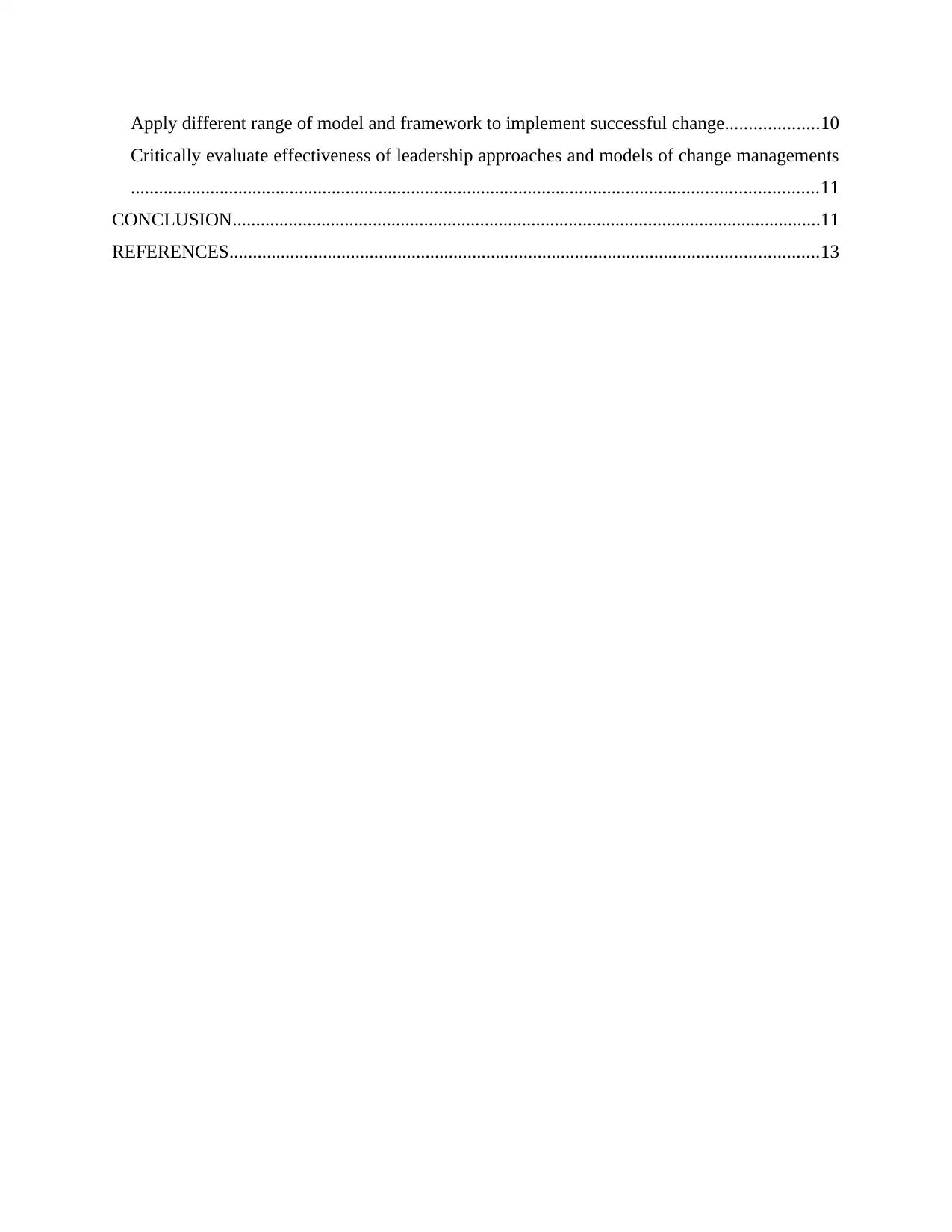
Apply different range of model and framework to implement successful change....................10
Critically evaluate effectiveness of leadership approaches and models of change managements
...................................................................................................................................................11
CONCLUSION..............................................................................................................................11
REFERENCES..............................................................................................................................13
Critically evaluate effectiveness of leadership approaches and models of change managements
...................................................................................................................................................11
CONCLUSION..............................................................................................................................11
REFERENCES..............................................................................................................................13
⊘ This is a preview!⊘
Do you want full access?
Subscribe today to unlock all pages.

Trusted by 1+ million students worldwide
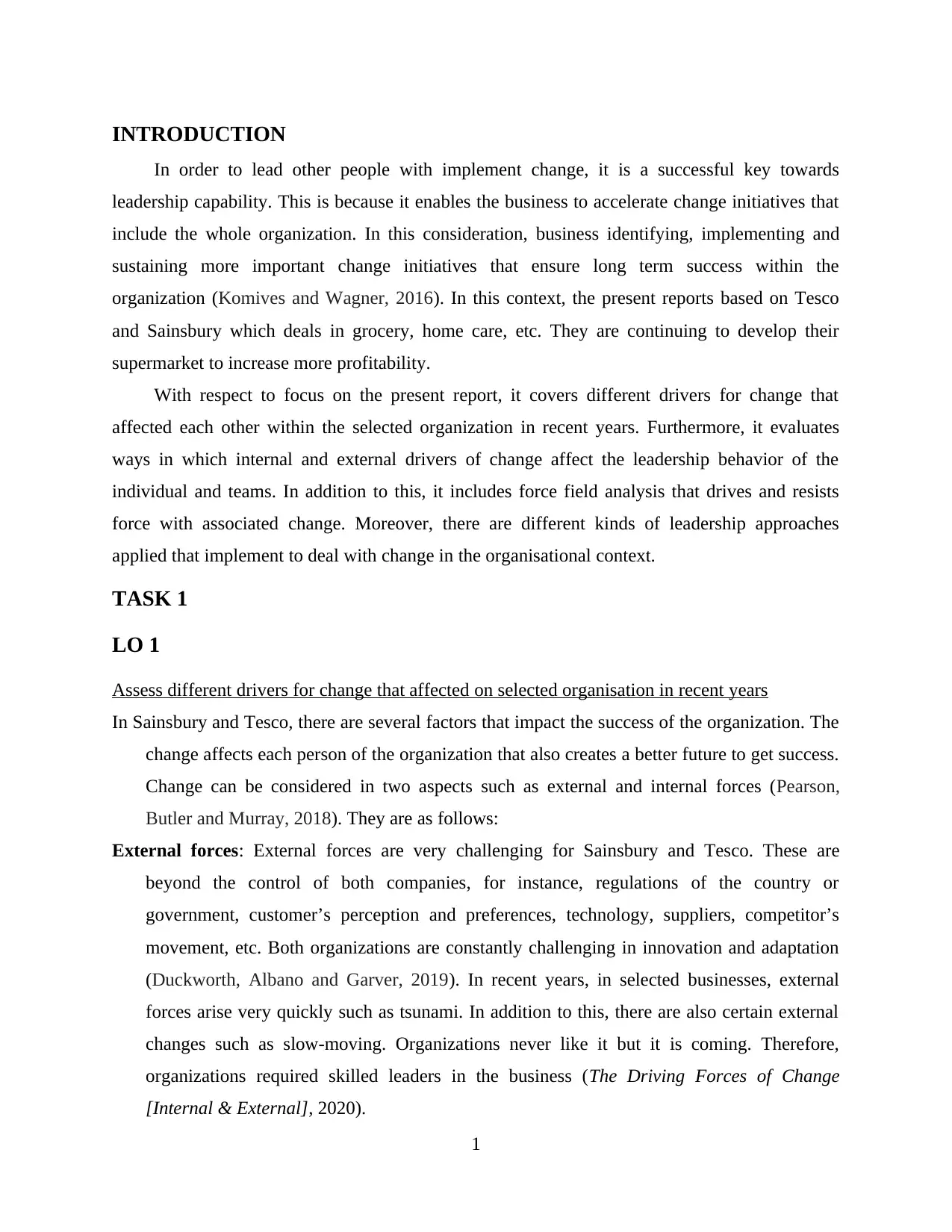
INTRODUCTION
In order to lead other people with implement change, it is a successful key towards
leadership capability. This is because it enables the business to accelerate change initiatives that
include the whole organization. In this consideration, business identifying, implementing and
sustaining more important change initiatives that ensure long term success within the
organization (Komives and Wagner, 2016). In this context, the present reports based on Tesco
and Sainsbury which deals in grocery, home care, etc. They are continuing to develop their
supermarket to increase more profitability.
With respect to focus on the present report, it covers different drivers for change that
affected each other within the selected organization in recent years. Furthermore, it evaluates
ways in which internal and external drivers of change affect the leadership behavior of the
individual and teams. In addition to this, it includes force field analysis that drives and resists
force with associated change. Moreover, there are different kinds of leadership approaches
applied that implement to deal with change in the organisational context.
TASK 1
LO 1
Assess different drivers for change that affected on selected organisation in recent years
In Sainsbury and Tesco, there are several factors that impact the success of the organization. The
change affects each person of the organization that also creates a better future to get success.
Change can be considered in two aspects such as external and internal forces (Pearson,
Butler and Murray, 2018). They are as follows:
External forces: External forces are very challenging for Sainsbury and Tesco. These are
beyond the control of both companies, for instance, regulations of the country or
government, customer’s perception and preferences, technology, suppliers, competitor’s
movement, etc. Both organizations are constantly challenging in innovation and adaptation
(Duckworth, Albano and Garver, 2019). In recent years, in selected businesses, external
forces arise very quickly such as tsunami. In addition to this, there are also certain external
changes such as slow-moving. Organizations never like it but it is coming. Therefore,
organizations required skilled leaders in the business (The Driving Forces of Change
[Internal & External], 2020).
1
In order to lead other people with implement change, it is a successful key towards
leadership capability. This is because it enables the business to accelerate change initiatives that
include the whole organization. In this consideration, business identifying, implementing and
sustaining more important change initiatives that ensure long term success within the
organization (Komives and Wagner, 2016). In this context, the present reports based on Tesco
and Sainsbury which deals in grocery, home care, etc. They are continuing to develop their
supermarket to increase more profitability.
With respect to focus on the present report, it covers different drivers for change that
affected each other within the selected organization in recent years. Furthermore, it evaluates
ways in which internal and external drivers of change affect the leadership behavior of the
individual and teams. In addition to this, it includes force field analysis that drives and resists
force with associated change. Moreover, there are different kinds of leadership approaches
applied that implement to deal with change in the organisational context.
TASK 1
LO 1
Assess different drivers for change that affected on selected organisation in recent years
In Sainsbury and Tesco, there are several factors that impact the success of the organization. The
change affects each person of the organization that also creates a better future to get success.
Change can be considered in two aspects such as external and internal forces (Pearson,
Butler and Murray, 2018). They are as follows:
External forces: External forces are very challenging for Sainsbury and Tesco. These are
beyond the control of both companies, for instance, regulations of the country or
government, customer’s perception and preferences, technology, suppliers, competitor’s
movement, etc. Both organizations are constantly challenging in innovation and adaptation
(Duckworth, Albano and Garver, 2019). In recent years, in selected businesses, external
forces arise very quickly such as tsunami. In addition to this, there are also certain external
changes such as slow-moving. Organizations never like it but it is coming. Therefore,
organizations required skilled leaders in the business (The Driving Forces of Change
[Internal & External], 2020).
1
Paraphrase This Document
Need a fresh take? Get an instant paraphrase of this document with our AI Paraphraser
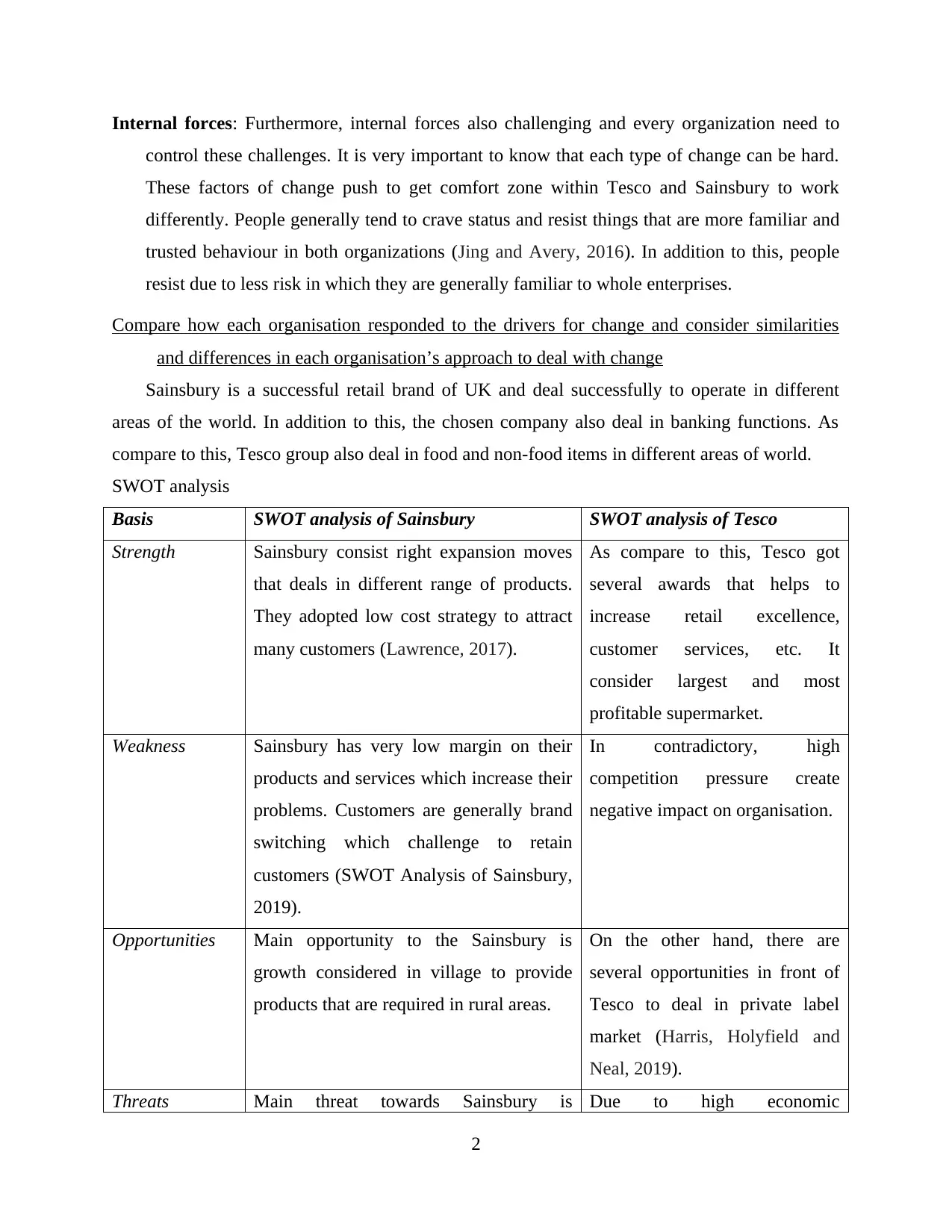
Internal forces: Furthermore, internal forces also challenging and every organization need to
control these challenges. It is very important to know that each type of change can be hard.
These factors of change push to get comfort zone within Tesco and Sainsbury to work
differently. People generally tend to crave status and resist things that are more familiar and
trusted behaviour in both organizations (Jing and Avery, 2016). In addition to this, people
resist due to less risk in which they are generally familiar to whole enterprises.
Compare how each organisation responded to the drivers for change and consider similarities
and differences in each organisation’s approach to deal with change
Sainsbury is a successful retail brand of UK and deal successfully to operate in different
areas of the world. In addition to this, the chosen company also deal in banking functions. As
compare to this, Tesco group also deal in food and non-food items in different areas of world.
SWOT analysis
Basis SWOT analysis of Sainsbury SWOT analysis of Tesco
Strength Sainsbury consist right expansion moves
that deals in different range of products.
They adopted low cost strategy to attract
many customers (Lawrence, 2017).
As compare to this, Tesco got
several awards that helps to
increase retail excellence,
customer services, etc. It
consider largest and most
profitable supermarket.
Weakness Sainsbury has very low margin on their
products and services which increase their
problems. Customers are generally brand
switching which challenge to retain
customers (SWOT Analysis of Sainsbury,
2019).
In contradictory, high
competition pressure create
negative impact on organisation.
Opportunities Main opportunity to the Sainsbury is
growth considered in village to provide
products that are required in rural areas.
On the other hand, there are
several opportunities in front of
Tesco to deal in private label
market (Harris, Holyfield and
Neal, 2019).
Threats Main threat towards Sainsbury is Due to high economic
2
control these challenges. It is very important to know that each type of change can be hard.
These factors of change push to get comfort zone within Tesco and Sainsbury to work
differently. People generally tend to crave status and resist things that are more familiar and
trusted behaviour in both organizations (Jing and Avery, 2016). In addition to this, people
resist due to less risk in which they are generally familiar to whole enterprises.
Compare how each organisation responded to the drivers for change and consider similarities
and differences in each organisation’s approach to deal with change
Sainsbury is a successful retail brand of UK and deal successfully to operate in different
areas of the world. In addition to this, the chosen company also deal in banking functions. As
compare to this, Tesco group also deal in food and non-food items in different areas of world.
SWOT analysis
Basis SWOT analysis of Sainsbury SWOT analysis of Tesco
Strength Sainsbury consist right expansion moves
that deals in different range of products.
They adopted low cost strategy to attract
many customers (Lawrence, 2017).
As compare to this, Tesco got
several awards that helps to
increase retail excellence,
customer services, etc. It
consider largest and most
profitable supermarket.
Weakness Sainsbury has very low margin on their
products and services which increase their
problems. Customers are generally brand
switching which challenge to retain
customers (SWOT Analysis of Sainsbury,
2019).
In contradictory, high
competition pressure create
negative impact on organisation.
Opportunities Main opportunity to the Sainsbury is
growth considered in village to provide
products that are required in rural areas.
On the other hand, there are
several opportunities in front of
Tesco to deal in private label
market (Harris, Holyfield and
Neal, 2019).
Threats Main threat towards Sainsbury is Due to high economic
2
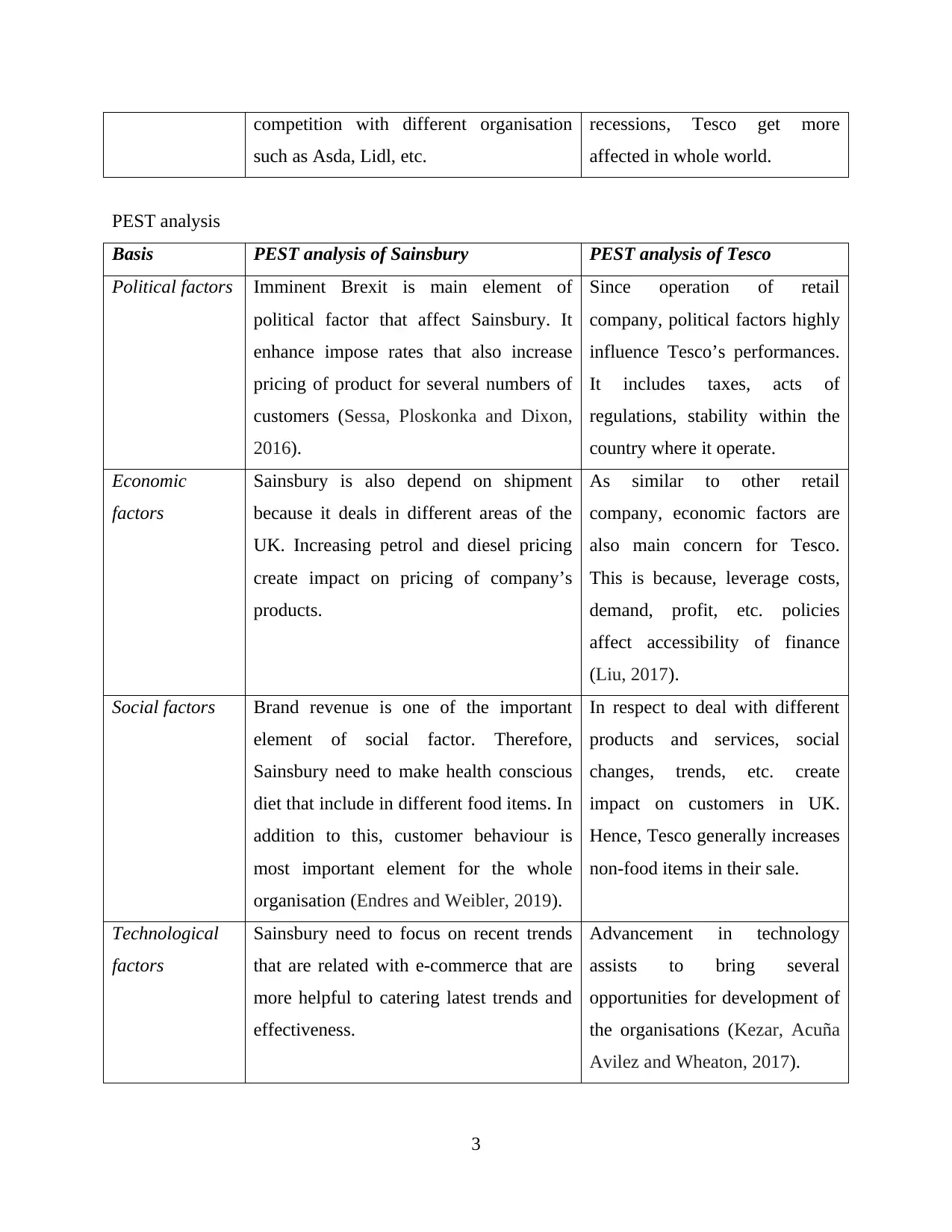
competition with different organisation
such as Asda, Lidl, etc.
recessions, Tesco get more
affected in whole world.
PEST analysis
Basis PEST analysis of Sainsbury PEST analysis of Tesco
Political factors Imminent Brexit is main element of
political factor that affect Sainsbury. It
enhance impose rates that also increase
pricing of product for several numbers of
customers (Sessa, Ploskonka and Dixon,
2016).
Since operation of retail
company, political factors highly
influence Tesco’s performances.
It includes taxes, acts of
regulations, stability within the
country where it operate.
Economic
factors
Sainsbury is also depend on shipment
because it deals in different areas of the
UK. Increasing petrol and diesel pricing
create impact on pricing of company’s
products.
As similar to other retail
company, economic factors are
also main concern for Tesco.
This is because, leverage costs,
demand, profit, etc. policies
affect accessibility of finance
(Liu, 2017).
Social factors Brand revenue is one of the important
element of social factor. Therefore,
Sainsbury need to make health conscious
diet that include in different food items. In
addition to this, customer behaviour is
most important element for the whole
organisation (Endres and Weibler, 2019).
In respect to deal with different
products and services, social
changes, trends, etc. create
impact on customers in UK.
Hence, Tesco generally increases
non-food items in their sale.
Technological
factors
Sainsbury need to focus on recent trends
that are related with e-commerce that are
more helpful to catering latest trends and
effectiveness.
Advancement in technology
assists to bring several
opportunities for development of
the organisations (Kezar, Acuña
Avilez and Wheaton, 2017).
3
such as Asda, Lidl, etc.
recessions, Tesco get more
affected in whole world.
PEST analysis
Basis PEST analysis of Sainsbury PEST analysis of Tesco
Political factors Imminent Brexit is main element of
political factor that affect Sainsbury. It
enhance impose rates that also increase
pricing of product for several numbers of
customers (Sessa, Ploskonka and Dixon,
2016).
Since operation of retail
company, political factors highly
influence Tesco’s performances.
It includes taxes, acts of
regulations, stability within the
country where it operate.
Economic
factors
Sainsbury is also depend on shipment
because it deals in different areas of the
UK. Increasing petrol and diesel pricing
create impact on pricing of company’s
products.
As similar to other retail
company, economic factors are
also main concern for Tesco.
This is because, leverage costs,
demand, profit, etc. policies
affect accessibility of finance
(Liu, 2017).
Social factors Brand revenue is one of the important
element of social factor. Therefore,
Sainsbury need to make health conscious
diet that include in different food items. In
addition to this, customer behaviour is
most important element for the whole
organisation (Endres and Weibler, 2019).
In respect to deal with different
products and services, social
changes, trends, etc. create
impact on customers in UK.
Hence, Tesco generally increases
non-food items in their sale.
Technological
factors
Sainsbury need to focus on recent trends
that are related with e-commerce that are
more helpful to catering latest trends and
effectiveness.
Advancement in technology
assists to bring several
opportunities for development of
the organisations (Kezar, Acuña
Avilez and Wheaton, 2017).
3
⊘ This is a preview!⊘
Do you want full access?
Subscribe today to unlock all pages.

Trusted by 1+ million students worldwide
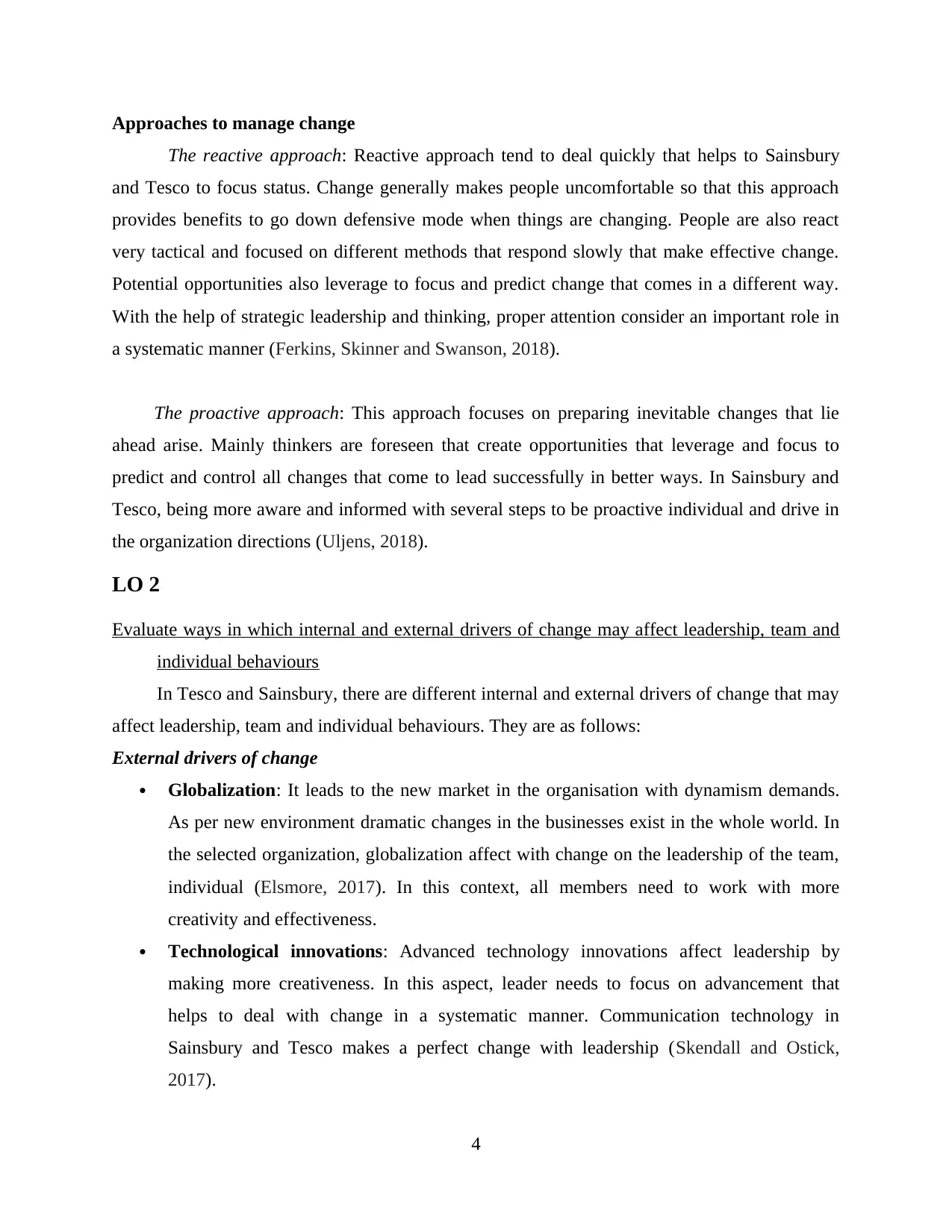
Approaches to manage change
The reactive approach: Reactive approach tend to deal quickly that helps to Sainsbury
and Tesco to focus status. Change generally makes people uncomfortable so that this approach
provides benefits to go down defensive mode when things are changing. People are also react
very tactical and focused on different methods that respond slowly that make effective change.
Potential opportunities also leverage to focus and predict change that comes in a different way.
With the help of strategic leadership and thinking, proper attention consider an important role in
a systematic manner (Ferkins, Skinner and Swanson, 2018).
The proactive approach: This approach focuses on preparing inevitable changes that lie
ahead arise. Mainly thinkers are foreseen that create opportunities that leverage and focus to
predict and control all changes that come to lead successfully in better ways. In Sainsbury and
Tesco, being more aware and informed with several steps to be proactive individual and drive in
the organization directions (Uljens, 2018).
LO 2
Evaluate ways in which internal and external drivers of change may affect leadership, team and
individual behaviours
In Tesco and Sainsbury, there are different internal and external drivers of change that may
affect leadership, team and individual behaviours. They are as follows:
External drivers of change
Globalization: It leads to the new market in the organisation with dynamism demands.
As per new environment dramatic changes in the businesses exist in the whole world. In
the selected organization, globalization affect with change on the leadership of the team,
individual (Elsmore, 2017). In this context, all members need to work with more
creativity and effectiveness.
Technological innovations: Advanced technology innovations affect leadership by
making more creativeness. In this aspect, leader needs to focus on advancement that
helps to deal with change in a systematic manner. Communication technology in
Sainsbury and Tesco makes a perfect change with leadership (Skendall and Ostick,
2017).
4
The reactive approach: Reactive approach tend to deal quickly that helps to Sainsbury
and Tesco to focus status. Change generally makes people uncomfortable so that this approach
provides benefits to go down defensive mode when things are changing. People are also react
very tactical and focused on different methods that respond slowly that make effective change.
Potential opportunities also leverage to focus and predict change that comes in a different way.
With the help of strategic leadership and thinking, proper attention consider an important role in
a systematic manner (Ferkins, Skinner and Swanson, 2018).
The proactive approach: This approach focuses on preparing inevitable changes that lie
ahead arise. Mainly thinkers are foreseen that create opportunities that leverage and focus to
predict and control all changes that come to lead successfully in better ways. In Sainsbury and
Tesco, being more aware and informed with several steps to be proactive individual and drive in
the organization directions (Uljens, 2018).
LO 2
Evaluate ways in which internal and external drivers of change may affect leadership, team and
individual behaviours
In Tesco and Sainsbury, there are different internal and external drivers of change that may
affect leadership, team and individual behaviours. They are as follows:
External drivers of change
Globalization: It leads to the new market in the organisation with dynamism demands.
As per new environment dramatic changes in the businesses exist in the whole world. In
the selected organization, globalization affect with change on the leadership of the team,
individual (Elsmore, 2017). In this context, all members need to work with more
creativity and effectiveness.
Technological innovations: Advanced technology innovations affect leadership by
making more creativeness. In this aspect, leader needs to focus on advancement that
helps to deal with change in a systematic manner. Communication technology in
Sainsbury and Tesco makes a perfect change with leadership (Skendall and Ostick,
2017).
4
Paraphrase This Document
Need a fresh take? Get an instant paraphrase of this document with our AI Paraphraser
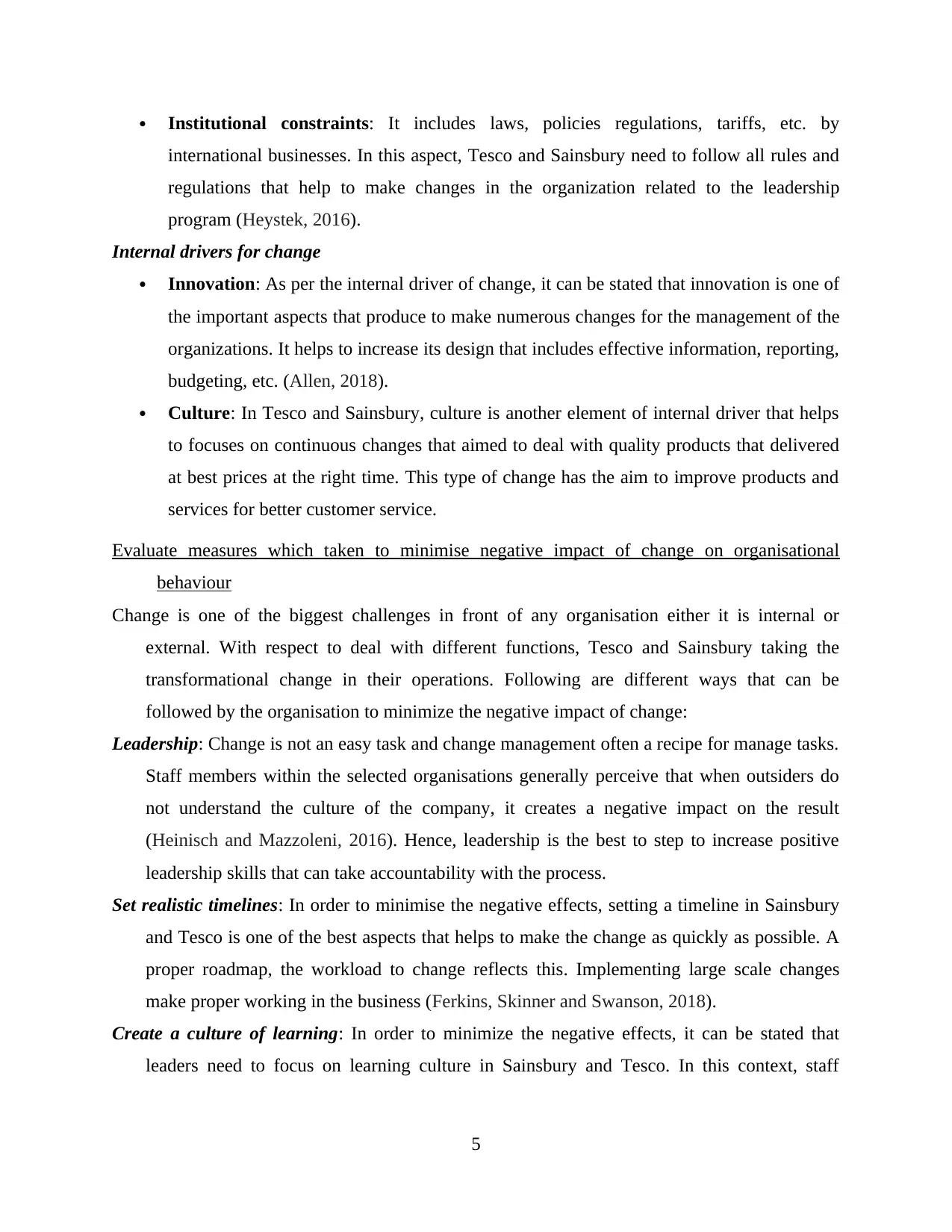
Institutional constraints: It includes laws, policies regulations, tariffs, etc. by
international businesses. In this aspect, Tesco and Sainsbury need to follow all rules and
regulations that help to make changes in the organization related to the leadership
program (Heystek, 2016).
Internal drivers for change
Innovation: As per the internal driver of change, it can be stated that innovation is one of
the important aspects that produce to make numerous changes for the management of the
organizations. It helps to increase its design that includes effective information, reporting,
budgeting, etc. (Allen, 2018).
Culture: In Tesco and Sainsbury, culture is another element of internal driver that helps
to focuses on continuous changes that aimed to deal with quality products that delivered
at best prices at the right time. This type of change has the aim to improve products and
services for better customer service.
Evaluate measures which taken to minimise negative impact of change on organisational
behaviour
Change is one of the biggest challenges in front of any organisation either it is internal or
external. With respect to deal with different functions, Tesco and Sainsbury taking the
transformational change in their operations. Following are different ways that can be
followed by the organisation to minimize the negative impact of change:
Leadership: Change is not an easy task and change management often a recipe for manage tasks.
Staff members within the selected organisations generally perceive that when outsiders do
not understand the culture of the company, it creates a negative impact on the result
(Heinisch and Mazzoleni, 2016). Hence, leadership is the best to step to increase positive
leadership skills that can take accountability with the process.
Set realistic timelines: In order to minimise the negative effects, setting a timeline in Sainsbury
and Tesco is one of the best aspects that helps to make the change as quickly as possible. A
proper roadmap, the workload to change reflects this. Implementing large scale changes
make proper working in the business (Ferkins, Skinner and Swanson, 2018).
Create a culture of learning: In order to minimize the negative effects, it can be stated that
leaders need to focus on learning culture in Sainsbury and Tesco. In this context, staff
5
international businesses. In this aspect, Tesco and Sainsbury need to follow all rules and
regulations that help to make changes in the organization related to the leadership
program (Heystek, 2016).
Internal drivers for change
Innovation: As per the internal driver of change, it can be stated that innovation is one of
the important aspects that produce to make numerous changes for the management of the
organizations. It helps to increase its design that includes effective information, reporting,
budgeting, etc. (Allen, 2018).
Culture: In Tesco and Sainsbury, culture is another element of internal driver that helps
to focuses on continuous changes that aimed to deal with quality products that delivered
at best prices at the right time. This type of change has the aim to improve products and
services for better customer service.
Evaluate measures which taken to minimise negative impact of change on organisational
behaviour
Change is one of the biggest challenges in front of any organisation either it is internal or
external. With respect to deal with different functions, Tesco and Sainsbury taking the
transformational change in their operations. Following are different ways that can be
followed by the organisation to minimize the negative impact of change:
Leadership: Change is not an easy task and change management often a recipe for manage tasks.
Staff members within the selected organisations generally perceive that when outsiders do
not understand the culture of the company, it creates a negative impact on the result
(Heinisch and Mazzoleni, 2016). Hence, leadership is the best to step to increase positive
leadership skills that can take accountability with the process.
Set realistic timelines: In order to minimise the negative effects, setting a timeline in Sainsbury
and Tesco is one of the best aspects that helps to make the change as quickly as possible. A
proper roadmap, the workload to change reflects this. Implementing large scale changes
make proper working in the business (Ferkins, Skinner and Swanson, 2018).
Create a culture of learning: In order to minimize the negative effects, it can be stated that
leaders need to focus on learning culture in Sainsbury and Tesco. In this context, staff
5
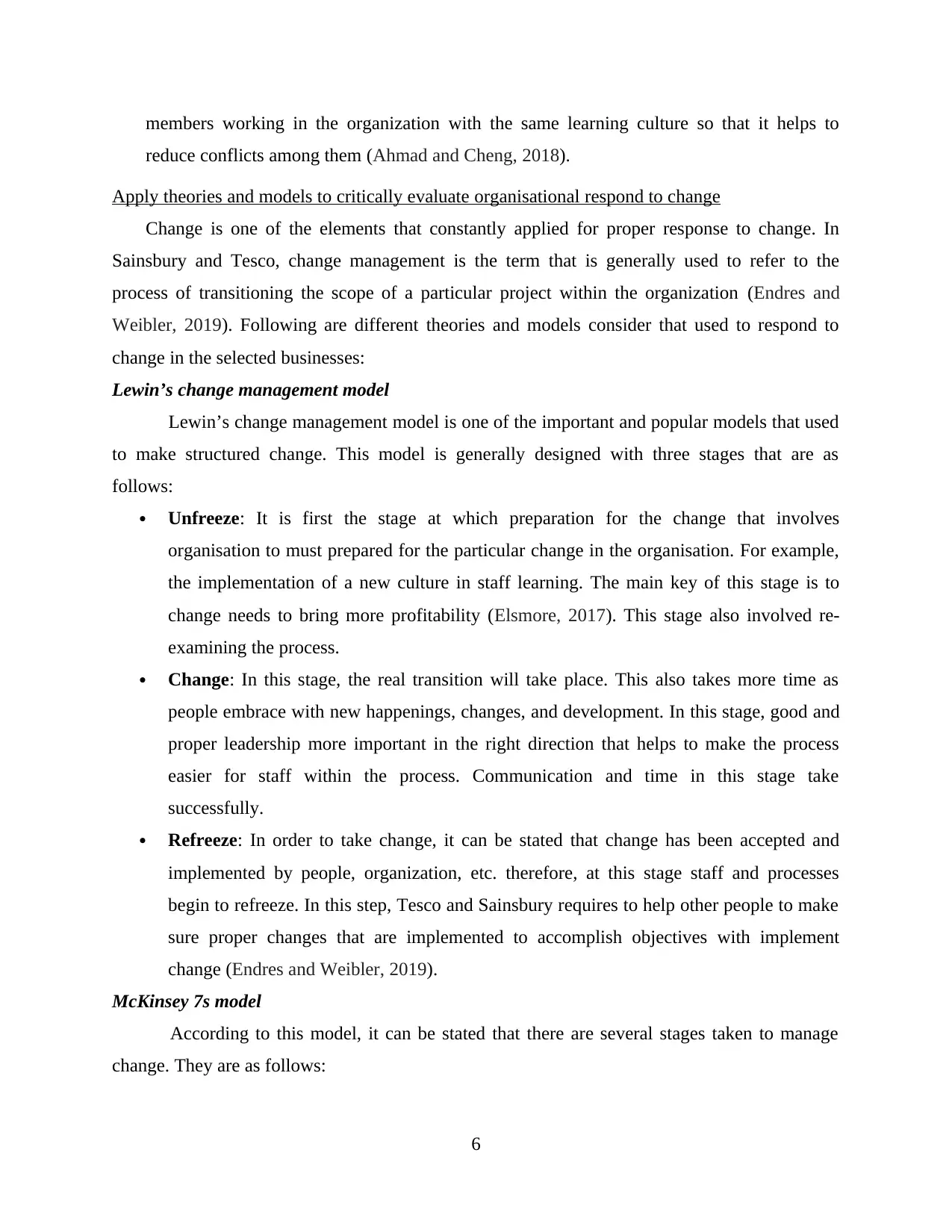
members working in the organization with the same learning culture so that it helps to
reduce conflicts among them (Ahmad and Cheng, 2018).
Apply theories and models to critically evaluate organisational respond to change
Change is one of the elements that constantly applied for proper response to change. In
Sainsbury and Tesco, change management is the term that is generally used to refer to the
process of transitioning the scope of a particular project within the organization (Endres and
Weibler, 2019). Following are different theories and models consider that used to respond to
change in the selected businesses:
Lewin’s change management model
Lewin’s change management model is one of the important and popular models that used
to make structured change. This model is generally designed with three stages that are as
follows:
Unfreeze: It is first the stage at which preparation for the change that involves
organisation to must prepared for the particular change in the organisation. For example,
the implementation of a new culture in staff learning. The main key of this stage is to
change needs to bring more profitability (Elsmore, 2017). This stage also involved re-
examining the process.
Change: In this stage, the real transition will take place. This also takes more time as
people embrace with new happenings, changes, and development. In this stage, good and
proper leadership more important in the right direction that helps to make the process
easier for staff within the process. Communication and time in this stage take
successfully.
Refreeze: In order to take change, it can be stated that change has been accepted and
implemented by people, organization, etc. therefore, at this stage staff and processes
begin to refreeze. In this step, Tesco and Sainsbury requires to help other people to make
sure proper changes that are implemented to accomplish objectives with implement
change (Endres and Weibler, 2019).
McKinsey 7s model
According to this model, it can be stated that there are several stages taken to manage
change. They are as follows:
6
reduce conflicts among them (Ahmad and Cheng, 2018).
Apply theories and models to critically evaluate organisational respond to change
Change is one of the elements that constantly applied for proper response to change. In
Sainsbury and Tesco, change management is the term that is generally used to refer to the
process of transitioning the scope of a particular project within the organization (Endres and
Weibler, 2019). Following are different theories and models consider that used to respond to
change in the selected businesses:
Lewin’s change management model
Lewin’s change management model is one of the important and popular models that used
to make structured change. This model is generally designed with three stages that are as
follows:
Unfreeze: It is first the stage at which preparation for the change that involves
organisation to must prepared for the particular change in the organisation. For example,
the implementation of a new culture in staff learning. The main key of this stage is to
change needs to bring more profitability (Elsmore, 2017). This stage also involved re-
examining the process.
Change: In this stage, the real transition will take place. This also takes more time as
people embrace with new happenings, changes, and development. In this stage, good and
proper leadership more important in the right direction that helps to make the process
easier for staff within the process. Communication and time in this stage take
successfully.
Refreeze: In order to take change, it can be stated that change has been accepted and
implemented by people, organization, etc. therefore, at this stage staff and processes
begin to refreeze. In this step, Tesco and Sainsbury requires to help other people to make
sure proper changes that are implemented to accomplish objectives with implement
change (Endres and Weibler, 2019).
McKinsey 7s model
According to this model, it can be stated that there are several stages taken to manage
change. They are as follows:
6
⊘ This is a preview!⊘
Do you want full access?
Subscribe today to unlock all pages.

Trusted by 1+ million students worldwide
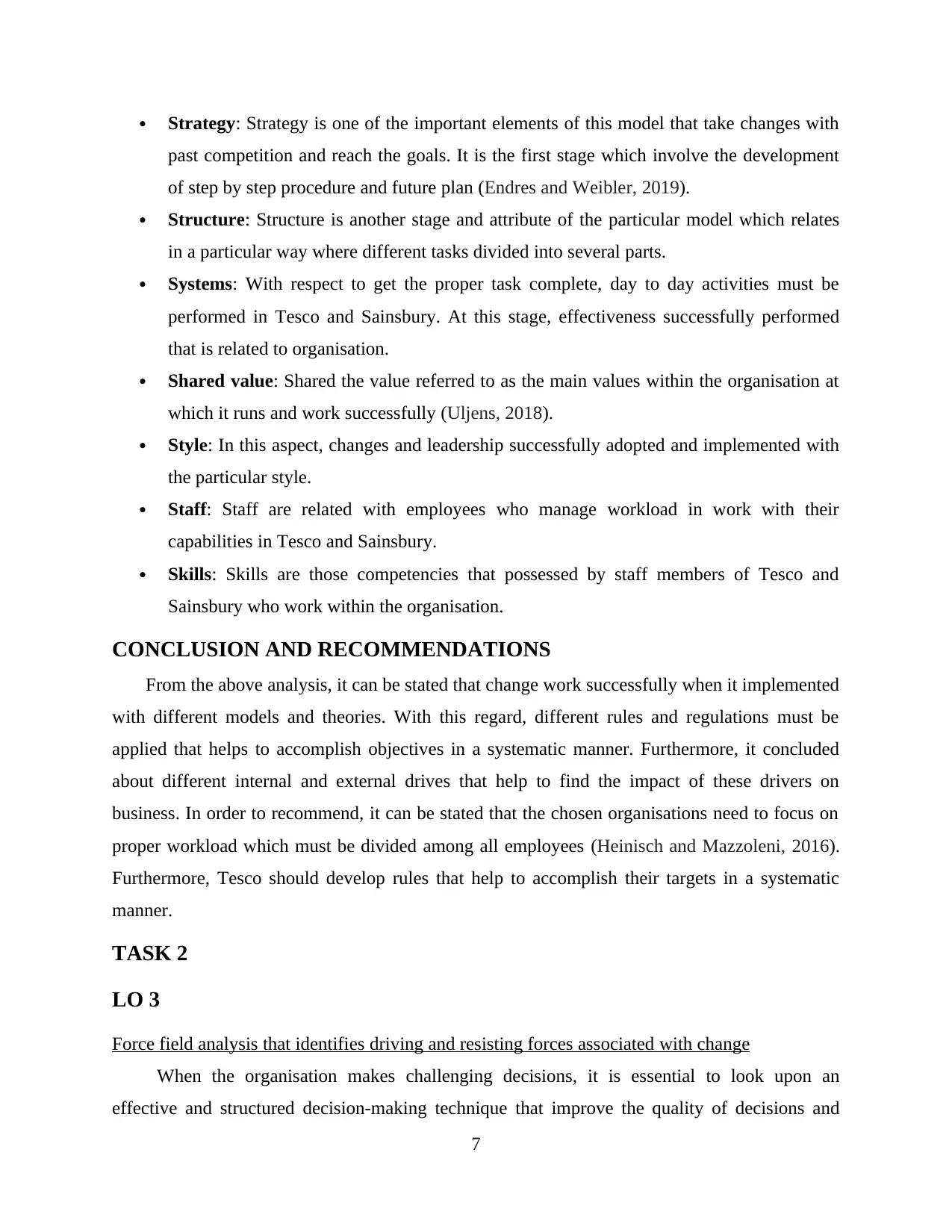
Strategy: Strategy is one of the important elements of this model that take changes with
past competition and reach the goals. It is the first stage which involve the development
of step by step procedure and future plan (Endres and Weibler, 2019).
Structure: Structure is another stage and attribute of the particular model which relates
in a particular way where different tasks divided into several parts.
Systems: With respect to get the proper task complete, day to day activities must be
performed in Tesco and Sainsbury. At this stage, effectiveness successfully performed
that is related to organisation.
Shared value: Shared the value referred to as the main values within the organisation at
which it runs and work successfully (Uljens, 2018).
Style: In this aspect, changes and leadership successfully adopted and implemented with
the particular style.
Staff: Staff are related with employees who manage workload in work with their
capabilities in Tesco and Sainsbury.
Skills: Skills are those competencies that possessed by staff members of Tesco and
Sainsbury who work within the organisation.
CONCLUSION AND RECOMMENDATIONS
From the above analysis, it can be stated that change work successfully when it implemented
with different models and theories. With this regard, different rules and regulations must be
applied that helps to accomplish objectives in a systematic manner. Furthermore, it concluded
about different internal and external drives that help to find the impact of these drivers on
business. In order to recommend, it can be stated that the chosen organisations need to focus on
proper workload which must be divided among all employees (Heinisch and Mazzoleni, 2016).
Furthermore, Tesco should develop rules that help to accomplish their targets in a systematic
manner.
TASK 2
LO 3
Force field analysis that identifies driving and resisting forces associated with change
When the organisation makes challenging decisions, it is essential to look upon an
effective and structured decision-making technique that improve the quality of decisions and
7
past competition and reach the goals. It is the first stage which involve the development
of step by step procedure and future plan (Endres and Weibler, 2019).
Structure: Structure is another stage and attribute of the particular model which relates
in a particular way where different tasks divided into several parts.
Systems: With respect to get the proper task complete, day to day activities must be
performed in Tesco and Sainsbury. At this stage, effectiveness successfully performed
that is related to organisation.
Shared value: Shared the value referred to as the main values within the organisation at
which it runs and work successfully (Uljens, 2018).
Style: In this aspect, changes and leadership successfully adopted and implemented with
the particular style.
Staff: Staff are related with employees who manage workload in work with their
capabilities in Tesco and Sainsbury.
Skills: Skills are those competencies that possessed by staff members of Tesco and
Sainsbury who work within the organisation.
CONCLUSION AND RECOMMENDATIONS
From the above analysis, it can be stated that change work successfully when it implemented
with different models and theories. With this regard, different rules and regulations must be
applied that helps to accomplish objectives in a systematic manner. Furthermore, it concluded
about different internal and external drives that help to find the impact of these drivers on
business. In order to recommend, it can be stated that the chosen organisations need to focus on
proper workload which must be divided among all employees (Heinisch and Mazzoleni, 2016).
Furthermore, Tesco should develop rules that help to accomplish their targets in a systematic
manner.
TASK 2
LO 3
Force field analysis that identifies driving and resisting forces associated with change
When the organisation makes challenging decisions, it is essential to look upon an
effective and structured decision-making technique that improve the quality of decisions and
7
Paraphrase This Document
Need a fresh take? Get an instant paraphrase of this document with our AI Paraphraser
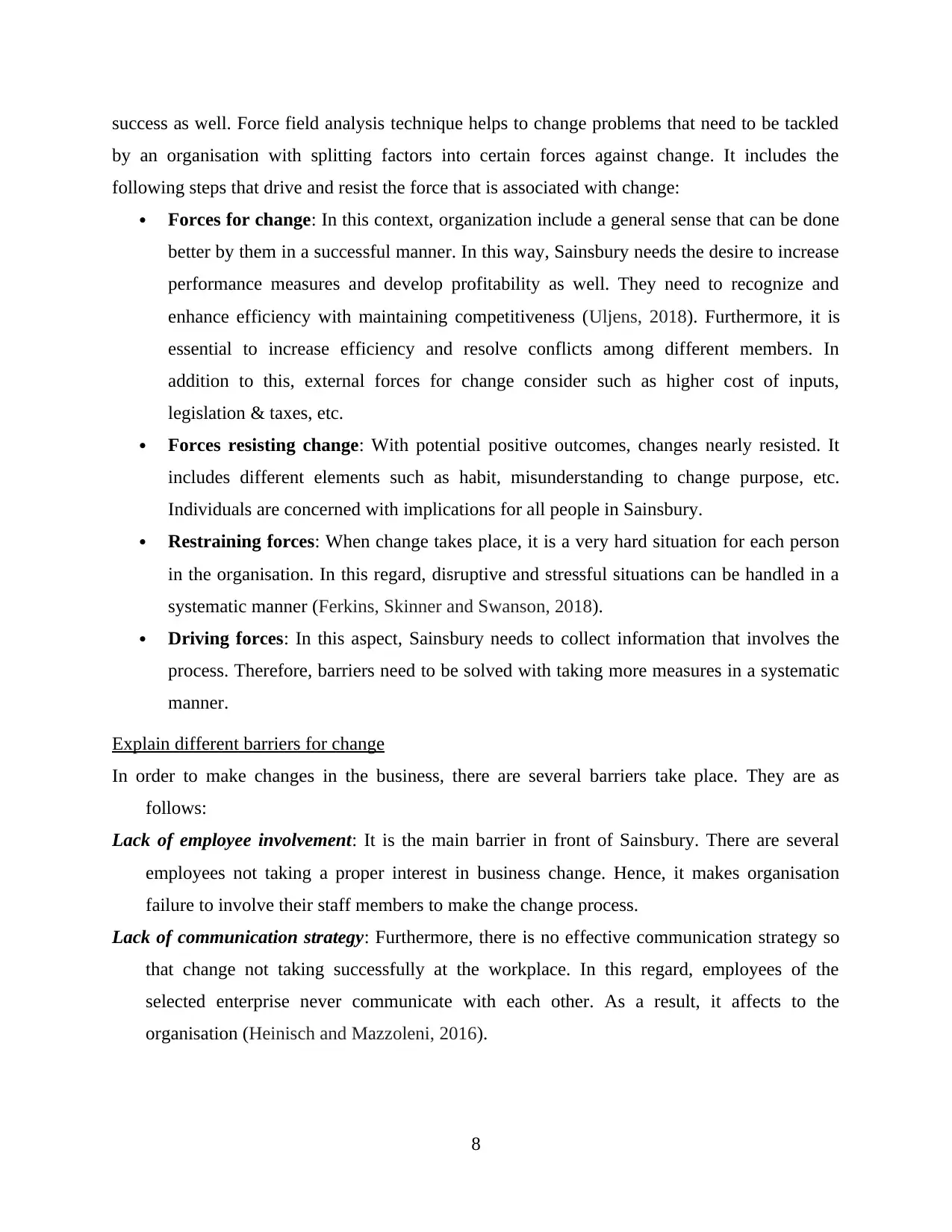
success as well. Force field analysis technique helps to change problems that need to be tackled
by an organisation with splitting factors into certain forces against change. It includes the
following steps that drive and resist the force that is associated with change:
Forces for change: In this context, organization include a general sense that can be done
better by them in a successful manner. In this way, Sainsbury needs the desire to increase
performance measures and develop profitability as well. They need to recognize and
enhance efficiency with maintaining competitiveness (Uljens, 2018). Furthermore, it is
essential to increase efficiency and resolve conflicts among different members. In
addition to this, external forces for change consider such as higher cost of inputs,
legislation & taxes, etc.
Forces resisting change: With potential positive outcomes, changes nearly resisted. It
includes different elements such as habit, misunderstanding to change purpose, etc.
Individuals are concerned with implications for all people in Sainsbury.
Restraining forces: When change takes place, it is a very hard situation for each person
in the organisation. In this regard, disruptive and stressful situations can be handled in a
systematic manner (Ferkins, Skinner and Swanson, 2018).
Driving forces: In this aspect, Sainsbury needs to collect information that involves the
process. Therefore, barriers need to be solved with taking more measures in a systematic
manner.
Explain different barriers for change
In order to make changes in the business, there are several barriers take place. They are as
follows:
Lack of employee involvement: It is the main barrier in front of Sainsbury. There are several
employees not taking a proper interest in business change. Hence, it makes organisation
failure to involve their staff members to make the change process.
Lack of communication strategy: Furthermore, there is no effective communication strategy so
that change not taking successfully at the workplace. In this regard, employees of the
selected enterprise never communicate with each other. As a result, it affects to the
organisation (Heinisch and Mazzoleni, 2016).
8
by an organisation with splitting factors into certain forces against change. It includes the
following steps that drive and resist the force that is associated with change:
Forces for change: In this context, organization include a general sense that can be done
better by them in a successful manner. In this way, Sainsbury needs the desire to increase
performance measures and develop profitability as well. They need to recognize and
enhance efficiency with maintaining competitiveness (Uljens, 2018). Furthermore, it is
essential to increase efficiency and resolve conflicts among different members. In
addition to this, external forces for change consider such as higher cost of inputs,
legislation & taxes, etc.
Forces resisting change: With potential positive outcomes, changes nearly resisted. It
includes different elements such as habit, misunderstanding to change purpose, etc.
Individuals are concerned with implications for all people in Sainsbury.
Restraining forces: When change takes place, it is a very hard situation for each person
in the organisation. In this regard, disruptive and stressful situations can be handled in a
systematic manner (Ferkins, Skinner and Swanson, 2018).
Driving forces: In this aspect, Sainsbury needs to collect information that involves the
process. Therefore, barriers need to be solved with taking more measures in a systematic
manner.
Explain different barriers for change
In order to make changes in the business, there are several barriers take place. They are as
follows:
Lack of employee involvement: It is the main barrier in front of Sainsbury. There are several
employees not taking a proper interest in business change. Hence, it makes organisation
failure to involve their staff members to make the change process.
Lack of communication strategy: Furthermore, there is no effective communication strategy so
that change not taking successfully at the workplace. In this regard, employees of the
selected enterprise never communicate with each other. As a result, it affects to the
organisation (Heinisch and Mazzoleni, 2016).
8
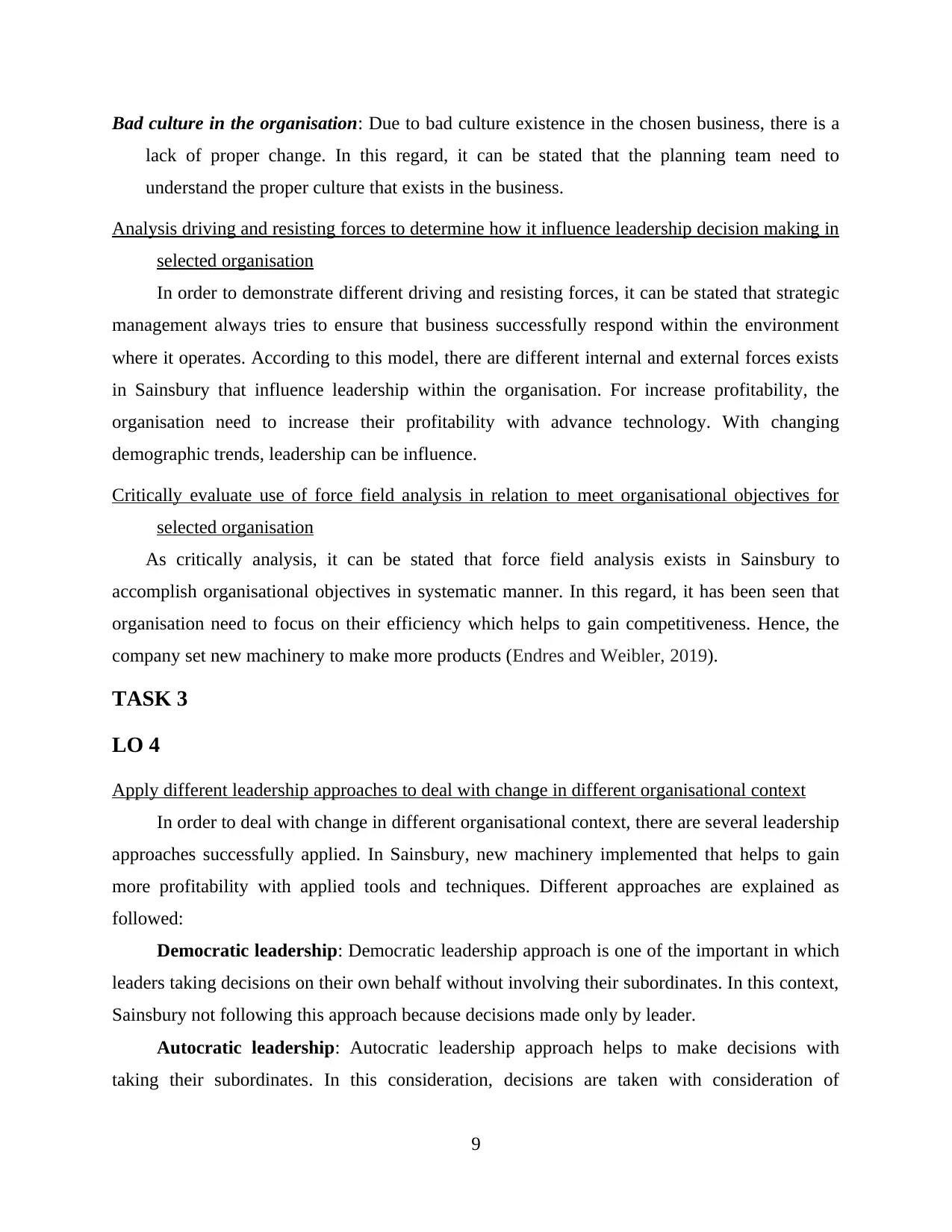
Bad culture in the organisation: Due to bad culture existence in the chosen business, there is a
lack of proper change. In this regard, it can be stated that the planning team need to
understand the proper culture that exists in the business.
Analysis driving and resisting forces to determine how it influence leadership decision making in
selected organisation
In order to demonstrate different driving and resisting forces, it can be stated that strategic
management always tries to ensure that business successfully respond within the environment
where it operates. According to this model, there are different internal and external forces exists
in Sainsbury that influence leadership within the organisation. For increase profitability, the
organisation need to increase their profitability with advance technology. With changing
demographic trends, leadership can be influence.
Critically evaluate use of force field analysis in relation to meet organisational objectives for
selected organisation
As critically analysis, it can be stated that force field analysis exists in Sainsbury to
accomplish organisational objectives in systematic manner. In this regard, it has been seen that
organisation need to focus on their efficiency which helps to gain competitiveness. Hence, the
company set new machinery to make more products (Endres and Weibler, 2019).
TASK 3
LO 4
Apply different leadership approaches to deal with change in different organisational context
In order to deal with change in different organisational context, there are several leadership
approaches successfully applied. In Sainsbury, new machinery implemented that helps to gain
more profitability with applied tools and techniques. Different approaches are explained as
followed:
Democratic leadership: Democratic leadership approach is one of the important in which
leaders taking decisions on their own behalf without involving their subordinates. In this context,
Sainsbury not following this approach because decisions made only by leader.
Autocratic leadership: Autocratic leadership approach helps to make decisions with
taking their subordinates. In this consideration, decisions are taken with consideration of
9
lack of proper change. In this regard, it can be stated that the planning team need to
understand the proper culture that exists in the business.
Analysis driving and resisting forces to determine how it influence leadership decision making in
selected organisation
In order to demonstrate different driving and resisting forces, it can be stated that strategic
management always tries to ensure that business successfully respond within the environment
where it operates. According to this model, there are different internal and external forces exists
in Sainsbury that influence leadership within the organisation. For increase profitability, the
organisation need to increase their profitability with advance technology. With changing
demographic trends, leadership can be influence.
Critically evaluate use of force field analysis in relation to meet organisational objectives for
selected organisation
As critically analysis, it can be stated that force field analysis exists in Sainsbury to
accomplish organisational objectives in systematic manner. In this regard, it has been seen that
organisation need to focus on their efficiency which helps to gain competitiveness. Hence, the
company set new machinery to make more products (Endres and Weibler, 2019).
TASK 3
LO 4
Apply different leadership approaches to deal with change in different organisational context
In order to deal with change in different organisational context, there are several leadership
approaches successfully applied. In Sainsbury, new machinery implemented that helps to gain
more profitability with applied tools and techniques. Different approaches are explained as
followed:
Democratic leadership: Democratic leadership approach is one of the important in which
leaders taking decisions on their own behalf without involving their subordinates. In this context,
Sainsbury not following this approach because decisions made only by leader.
Autocratic leadership: Autocratic leadership approach helps to make decisions with
taking their subordinates. In this consideration, decisions are taken with consideration of
9
⊘ This is a preview!⊘
Do you want full access?
Subscribe today to unlock all pages.

Trusted by 1+ million students worldwide
1 out of 16
Related Documents
Your All-in-One AI-Powered Toolkit for Academic Success.
+13062052269
info@desklib.com
Available 24*7 on WhatsApp / Email
![[object Object]](/_next/static/media/star-bottom.7253800d.svg)
Unlock your academic potential
Copyright © 2020–2025 A2Z Services. All Rights Reserved. Developed and managed by ZUCOL.




